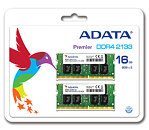- Joined
- Oct 9, 2007
- Messages
- 47,474 (7.50/day)
- Location
- Hyderabad, India
| System Name | RBMK-1000 |
|---|---|
| Processor | AMD Ryzen 7 5700G |
| Motherboard | ASUS ROG Strix B450-E Gaming |
| Cooling | DeepCool Gammax L240 V2 |
| Memory | 2x 8GB G.Skill Sniper X |
| Video Card(s) | Palit GeForce RTX 2080 SUPER GameRock |
| Storage | Western Digital Black NVMe 512GB |
| Display(s) | BenQ 1440p 60 Hz 27-inch |
| Case | Corsair Carbide 100R |
| Audio Device(s) | ASUS SupremeFX S1220A |
| Power Supply | Cooler Master MWE Gold 650W |
| Mouse | ASUS ROG Strix Impact |
| Keyboard | Gamdias Hermes E2 |
| Software | Windows 11 Pro |
ADATA Technology, a leading manufacturer of high performance DRAM modules and NAND Flash application products, today launched Premier DDR4 2133 SO-DIMM memory, optimized for best performance with new Intel Skylake processors and their chipsets, as well as the Haswell-E platform. ADATA is keen to expand DDR4 adoption and encourage the move to a new generation of DRAM on notebooks, as DDR4 offers outstanding performance and greater power efficiency, assured by meticulous ADATA testing and backed by a limited lifetime warranty.
ADATA Premier DDR4 2133 SO-DIMM modules are offered in 4GB and 8GB densities, both clocked to a high speed 2133 MHz. This represents a performance boost over DDR3, which on notebooks has typically been clocked at 1333 MHz or 1600 MHz. DDR4 therefore brings a new phase in computer memory performance and just as with desktop PCs, ADATA believes notebook users stand to gain much by choosing DDR4. This applies to new notebooks that ship with DDR4 and importantly as an upgrade option for notebooks that are compatible with DDR4 but purchased with DDR3 for cost reasons. ADATA encourages users to upgrade to DDR4 to enjoy the benefits of this essential technological advancement in personal computing.


Low Power Consumption for Longer Battery Life
DDR4 provides even more tangible benefits on portable PCs than on desktops. Since it delivers more computing power for lower energy draw, DDR4 increases performance while extending battery life and usage range. Premier DDR4 2133 SO-DIMM modules run 1.2V compared to 1.35V on DDR3 modules, a 20% reduction in consumption. This translates into considerably longer battery life per charge, and thus overall lower energy demand and environmental impact.
Uncompromising Quality
ADATA manufactures all DRAM modules to the strictest standards and JEDEC requirements. Users are guaranteed long-lasting, stable, and optimum performance backed by a limited lifetime warranty, ensuring the transition to new generation DDR4 is smooth and enjoyable. ADATA quality tests cover every aspect of DRAM selection, endurance, and platform compatibility for the finest user experience with every purchase.
View at TechPowerUp Main Site
ADATA Premier DDR4 2133 SO-DIMM modules are offered in 4GB and 8GB densities, both clocked to a high speed 2133 MHz. This represents a performance boost over DDR3, which on notebooks has typically been clocked at 1333 MHz or 1600 MHz. DDR4 therefore brings a new phase in computer memory performance and just as with desktop PCs, ADATA believes notebook users stand to gain much by choosing DDR4. This applies to new notebooks that ship with DDR4 and importantly as an upgrade option for notebooks that are compatible with DDR4 but purchased with DDR3 for cost reasons. ADATA encourages users to upgrade to DDR4 to enjoy the benefits of this essential technological advancement in personal computing.


Low Power Consumption for Longer Battery Life
DDR4 provides even more tangible benefits on portable PCs than on desktops. Since it delivers more computing power for lower energy draw, DDR4 increases performance while extending battery life and usage range. Premier DDR4 2133 SO-DIMM modules run 1.2V compared to 1.35V on DDR3 modules, a 20% reduction in consumption. This translates into considerably longer battery life per charge, and thus overall lower energy demand and environmental impact.
Uncompromising Quality
ADATA manufactures all DRAM modules to the strictest standards and JEDEC requirements. Users are guaranteed long-lasting, stable, and optimum performance backed by a limited lifetime warranty, ensuring the transition to new generation DDR4 is smooth and enjoyable. ADATA quality tests cover every aspect of DRAM selection, endurance, and platform compatibility for the finest user experience with every purchase.
View at TechPowerUp Main Site


